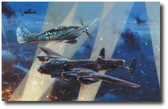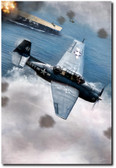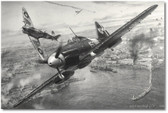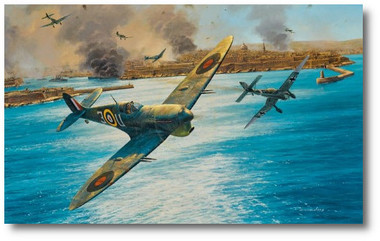 Loading... Please wait...
Loading... Please wait...- Home
- Aviation Art - By Artist
- Anthony Saunders
- Malta – The Turning Point
Categories
Malta – The Turning Point
Product Description
Malta – The Turning Point by Anthony Saunders
Limited edition of 275...$105.00
Overall print size: 26 ½" x 19 ¼"
Image Size: 20 ¾" x 12 ¾"
S/N by Artist Also available as...
25 Artist Proofs...$160.00
Plane type: Spitfire
For two years following the Italian Declaration of War against Britain in the summer of 1940, the tiny island of Malta became one of the most heavily bombed places on earth as the Axis air forces fought to force it into surrender. They hadn’t reckoned on the island’s resolve.
German High Command had long recognised that control of Malta, with its naval dockyards and RAF airfields, was pivotal to safeguarding Rommel’s entire North African campaign. Control of the island was essential to protect the convoys that supplied Rommel’s desert forces and the Germans and Italians decided to bomb the island into oblivion, starve it, and force it to surrender.
They almost succeeded: by April 1942 the dockyards had been devastated and the RAF reduced to a mere half dozen Spitfires and ageing Hurricanes. So dire was the situation that on 10 May the Axis Commander, Field Marshal Albert Kesselring, brazenly told Hitler that the island’s defences had been neutralised.
But he was wrong, and just as the Luftwaffe had underestimated British resolve in the Battle of Britain, so too did they misjudge the resolve of the Maltese people and her defenders.
On 20 April 1942 the American carrier USS Wasp flew in 46 Spitfires, but such was the intensity of air fighting that almost all were destroyed within a few days. But it was a start: on Saturday 9 May another 60 Spitfires flew to the island’s airfields, again from the Wasp and the British carrier HMS Eagle. The next day, just as Kesselring was bragging to the Führer of the island’s parlous state, most of those Spitfires were in action against a large force of Luftwaffe raiders, lavishly equipped with Ju87s, Ju88s and Bf109s. The German pilots were stunned by the ferocity of the opposition as, heavily outnumbered, the RAF fighter pilots, including volunteers from America, put up a tenacious defence.
The air battles that took place over Malta that day were the largest ever witnessed over the diminutive island and the unexpected Allied victory marked a turning point in the Mediterranean theatre. At the end of the day 57 enemy aircraft had been destroyed or damaged by RAF fighters and another eight had been shot down by flak. Never again would the Luftwaffe return with such force.








